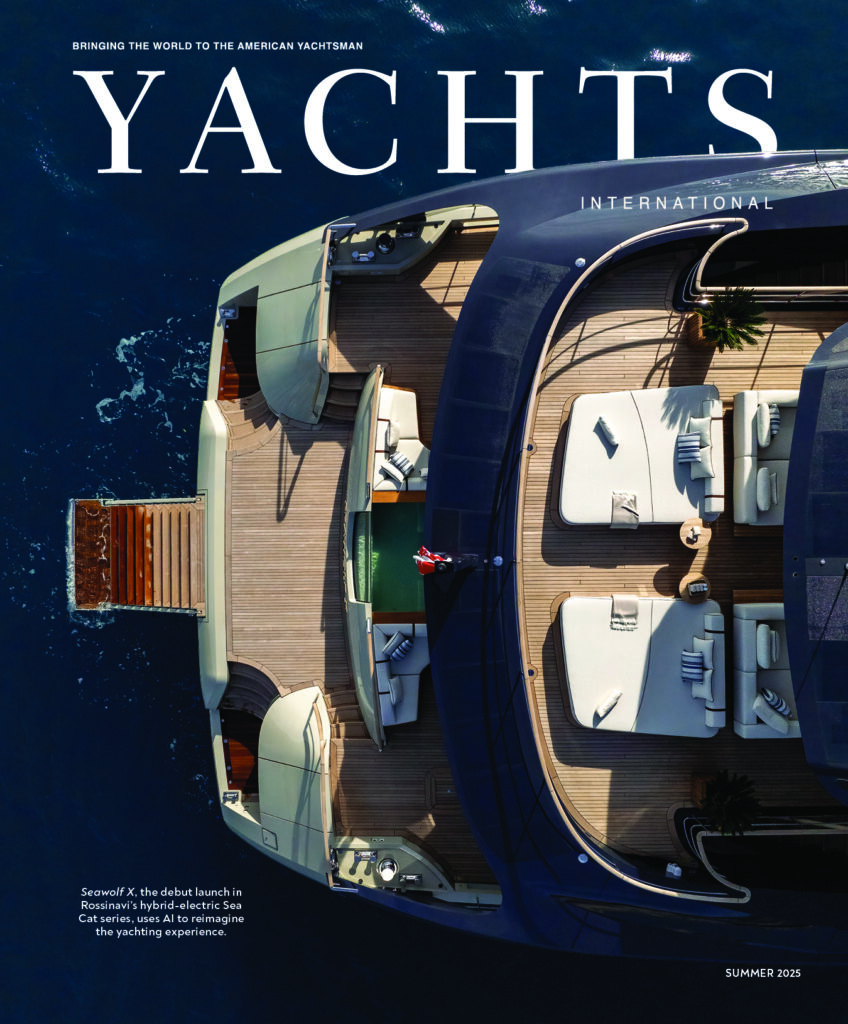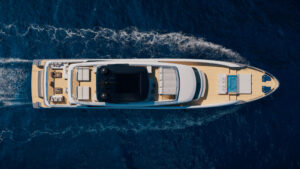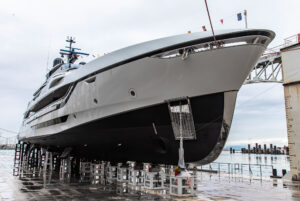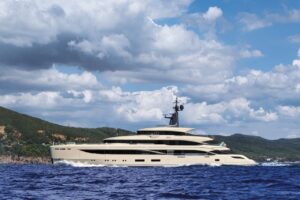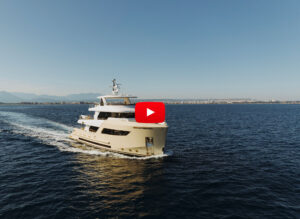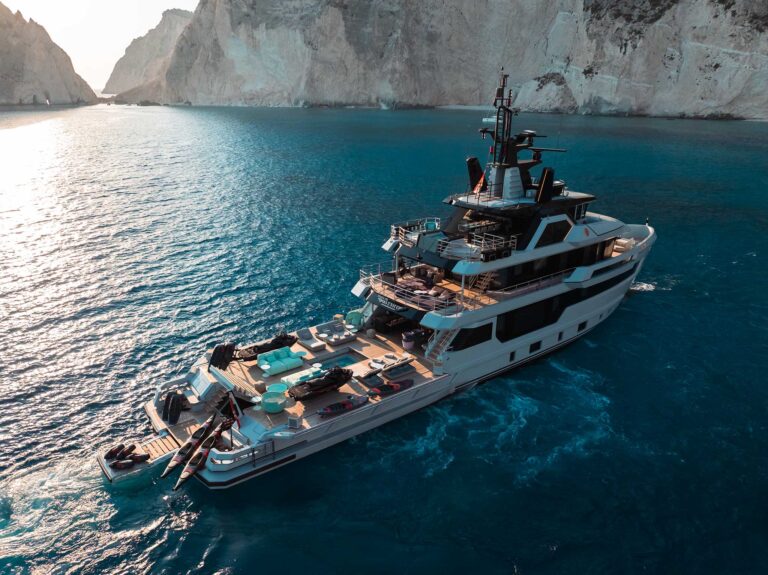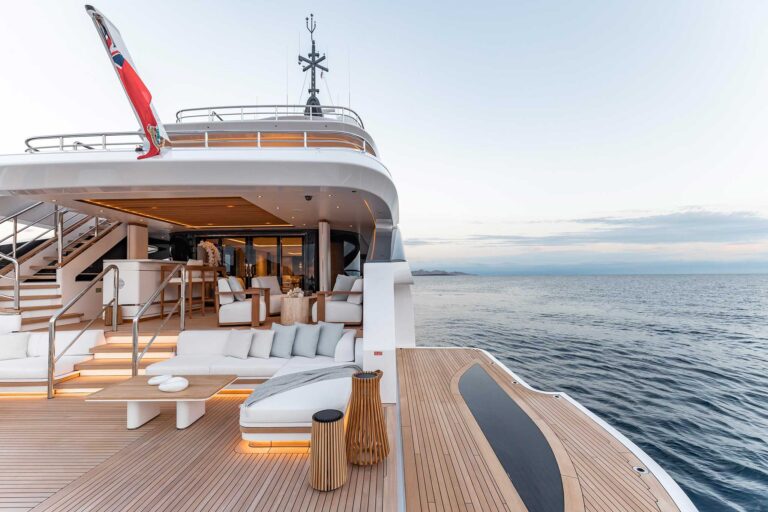Every so often, a boat comes along that really stands out from the crowd. The NISI 2400, slated to appear at the Miami and Palm Beach boat shows, is such a vessel. We got aboard.
Story by Bruce Maxwell

Styled by experienced offshore yachtsman and boatbuilder Christos Livadas and his wife Krina, working with North Carolina-based Setzer Design Group, this modern classic, just shy of 80’, is constructed to exacting commercial RINA and MCA certification, which has never been done at this length before.
Superyacht standards are evident everywhere and yet, despite the restrictions that safety rules impose, the NISI 2400 somehow manages to achieve a relaxed, beach-house feel, an aesthetic blending with the sea and its surroundings that is both pleasurable and palpable. “NISI embraces everything you need for a superior lifestyle experience: a mixture of relaxed chic, contemporary cool and understated elegance. She’s a one-of-a-kind blend of cutting-edge sensibility, excitement and style,” Livadas said.
We voyaged on the NISI 2400 soon after her launch. Observing her first from the dock, we note her lines sweeping back from a wave-piercing plumb bow to more flared aft sections (rather like a modern maxi racing yacht). Stainless-steel stanchions and lifelines accentuate the look. The advanced composite Kevlar hull is painted in a warm Alexseal metallic hazelnut color, and the mast is mocha.
A flybridge called an observation deck, a huge walk-through main deck with 11 enormous windows and ultra-sophisticated ensuite accommodations for eight in four staterooms, plus a cabin for two crew aft and triple 600-hp Cummins engines with Zeus pod propulsion (alternate engines include 2 x CAT C18s with ZF 4000 Pods or IPS Volvo Penta) cover the basics. But this does not begin to describe the amazing amount of thought and attention to detail that has gone into this boat.
The aft deck, reached from the swim platform where a 12′ jet rib sits in its carbon fiber garage, is more like a patio, offering a large outdoor sun bed and spacious hardtop-shaded teak-veneer table surrounded by an L-shaped lounge and individual armchairs. When we got under way, guests soon gravitated to this area. Teak decking here and along the wide port and starboard companionways is laid athwartships (rather than fore and aft), giving the impression that the beam is nearly 20′ wider than it actually is. But the first big surprise comes when the innovative curved, frameless doors fold back silently on Soss invisible hinges to reveal a large salon, modern galley and two-seat helm station, all blending seamlessly with the outer patio décor.
Four huge windows are resplendent port and starboard, and three more face forward, so guests can stand in the salon and experience a quite startling 360-degree view. Another L-shaped lounger, in high-end white washable fabrics from Belgium, is set up here around a glass-and-stainless-steel coffee table, which rises to dining-table height. Employing a further distinctly big-boat system, the ceiling is on hangers, and the salon sole and that of the master stateroom are floated on rubber (about two inches) for noise and vibration abatement.
Krina’s kitchen has a raised glass top on stainless-steel supports above white Italian and Greek marble veneer countertops, made with a process perfected by a Korean company. No plastic or Corian anywhere on this boat.
The standard InSinkErator disposal clashed with a dishwasher in NISI’s galley setup, so the shipyard custom-built one to fit. Most other equipment is European. Krina bought, for example, one of those intriguing Kohler faucets that folds away upon itself when not in use, and the multi-purpose stove is from Siemens. Another custom option available, often favored by European owners, is to locate the galley one level down.
Steps descend to a lobby, where a fridge and freezer face an enclosed utility and laundry with washing machine, dryer and fold-down ironing board. Then follows the smartest accommodations setup we have seen on anything smaller than a Feadship. The ensuite VIP stateroom is in the bow, with considerable locker and hanging space, and stretching aft from here is a stunning flush, white-suede-lined corridor, leading to two more ensuite guest staterooms. Most of the doors themselves are concealed in the suede.
The staterooms have full-length mirrors, whitewashed teak, self-opening and closing drawers and lockers, individual entertainment systems controlled by iPhones, mood LED lighting and marble-clad bathrooms with Italian Faenza six-nozzle showers plus two more overhead (including a detachable one). Astonishing. Remember, this is a 78′ boat, built under the 24m rule so that in Europe an owner can operate it with limited or no crew. Headboards in the staterooms are in champagne stingray skin, sourced from English company JMT, and bedspreads are white quilted affairs.
Continuing farther down the corridor, we encounter the beautifully designed master stateroom behind a large feature door. Made of 500 small strips of teak and mahogany, each of which was carefully crafted, sanded and oiled before it was carefully set around a central circular stainless-steel panel, this door alone took 12 weeks to complete.
The full-beam master features six-panel windows on either side. To port of the king-size bed with its striking brown-and-white Mongolian pony headboard, is a red earth-colored faux-leather top that becomes a vanity, while on the other is a lounging day bed that, when the cushions are removed, reveals a deep marble spa bath offering views of the scenery.
A frosted-glass door, which opens at the command of a switch, leads to the bathroom where this time the marble basin has been hewn from a whole marble block—and never mind weight saving. After careful weight management, this vessel tips the scales at a fraction more than 40 tons anyway. Faucets in both spa bath and bathroom are of the attractive waterblade type, by Ritmonio of Italy.
The flybridge is reached from the patio by minimalist custom steps that Christos says he prefers because they don’t take away from the sense of space on the main deck, but owners can also opt for a more traditional and substantial circular stairway. A sun bed area is aft aloft. Guests then walk through a “doorway” that supports the communications and navigation mast into a small-yet-comfortable lounge area where another set of full controls are located. When the vessel is at anchor, the helm seat reverses so that the driver can share a glass of bubbly with guests.
A tour of the outer decks reveals some interesting touches. To comply with RINA charter regulations, the stanchions and lifelines need to be even higher, but as that would adversely affect the profile, Christos capped them at a modest height, with screw-in, screw-out stainless steel plugs atop. If RINA compliance is necessary for a charter, it is then possible to add an extra set of lifelines, which are carried aboard.
“It is a bit like safety versus sexy,” Christos said. “When I said to RINA, the Italian classification society, that I wanted this vessel fully classed, which costs about $400,000 extra, they said I was crazy, but I am building these vessels in my new yard in Zhuhai, China, and I wanted to demonstrate that workmanship can comply on all fronts. In the end, RINA said it was an engineering miracle. We already have the innovative Argos Gulfstream series successfully launched and shown in Florida, and I think NISI, which means island in Greek, will attract considerable interest at $3.5 million non-classed, somewhat less than competitors in the same length, and with much better range and intrinsic value,” he added. The NISI range includes the 2200, 2400 and 2600 (the model number indicates its length in meters.)
Christos showed us the custom spring mooring cleats, which cleverly roll over into a recess when not in use, and we moved forward to yet another sun bed, then to a see-through sky hatch over the VIP stateroom, plus a deck hatch that gives access to a large storage compartment, and finally to the custom anchor pocket, which is Monaco-based project engineer Don Marshall’s pride and joy. “Fitting an anchor pocket on a plumb bow, which the NISI 2400 has, is very complicated. “It is really tricky to get the geometry of a big-ship anchoring system to work at this level. We built a balanced two-fluke Poole-type anchor so that the flukes would trip just as the stock comes inboard, and thankfully it worked,” Marshall said. A New Zealand-built Maxwell 2200 windlass complements the system.
Christos, still in his 30s, has owned multiple boats built in America, Europe and China after a successful early career in technology and industrial business ventures. He backed the NISI 2400 out of a tight berth at Club Marina Cove in Hong Kong, using joystick controls from the same SmartCraft company that supplied the state-of-the-art Skyhook system.
The boat doesn’t have a bow thruster, but he handled it like a baby, back and forth, until we headed toward the marina exit. The day crew rushing around with fenders in case we hit anything eventually realized that would not happen.
Christos has also introduced a Tricon-designed yacht management system for the NISI 2400, with software supplied by UK-based Energy Solutions, which allows the boat to plug in anywhere. It has a 120/220-volt 50-to-60 cycle system compatible in America and Europe and adjusts onboard power use as required. If shore power is not enough, for instance, the system may start a generator or turn off something that is not needed. Engine performance and tank levels in seven different zones are all available at the flick of a switch.
Heading out into Hebe Haven and Port Shelter, Christos fired up the triple Cummins and Zeus drives, and after a more genteel inland passage cruise for the guests, headed straight into the nor’east winter monsoon swell toward Dai Long Wan.
A powerful police launch following us fell way astern, waves breaking spectacularly over its bow, as we overtook another motoryacht wallowing in the waves. The NISI 2400 was traveling at 20 knots. The sharp bow entry and hull notches deflected water well clear of the decks. Except for one rogue wave, the decks were almost dry.
Top speed with this engine setup is presently showing 28 knots in trials, but the Tricon Marine team that built the boat is confident a few adjustments (including increasing the prop size) will allow the boat to reach 30 knots. The ability to make 1,500-nm passages at circa 9 knots is already a given, and that is a whole lot more than most other boats this size can manage.
Back aft, the engine room is spotless and has a see-through floor so that all-metal piping beneath the sole can be monitored. A cabin for two crew sits nearby.
In the endgame, Christos says he wants owners to rediscover yachting’s simple pleasures, and he seems on track to achieve just that. ■
For more information, visit nisiyachts.com
LOA: 78′ (23.5m)
LWL: 74′ (22.5m)
Beam: 19′ (5.75m)
Draft: 3.6′ (1.12m)
Engine options:3 x Cummins, 1,800 hp (other options available)
Propulsion: Zeus pods
Top speed: 28 knots
High-speed cruise: 23 knots
Range @ 9 knots: 1,500 nm
Fuel capacity: 1,409 gal. (5,334 L)
Fresh water: 558 gal. (2,100 L)
Black water: 200 gal. (757L)
Grey water: 200 gal. (757 L)
Concept and design: NISI Yachts/Setzer Design
Construction: Advanced composite Kevlar
Builder: Tricon Marine Group
Classification: RINA Charter, MCA Commercial (MGN 280)

